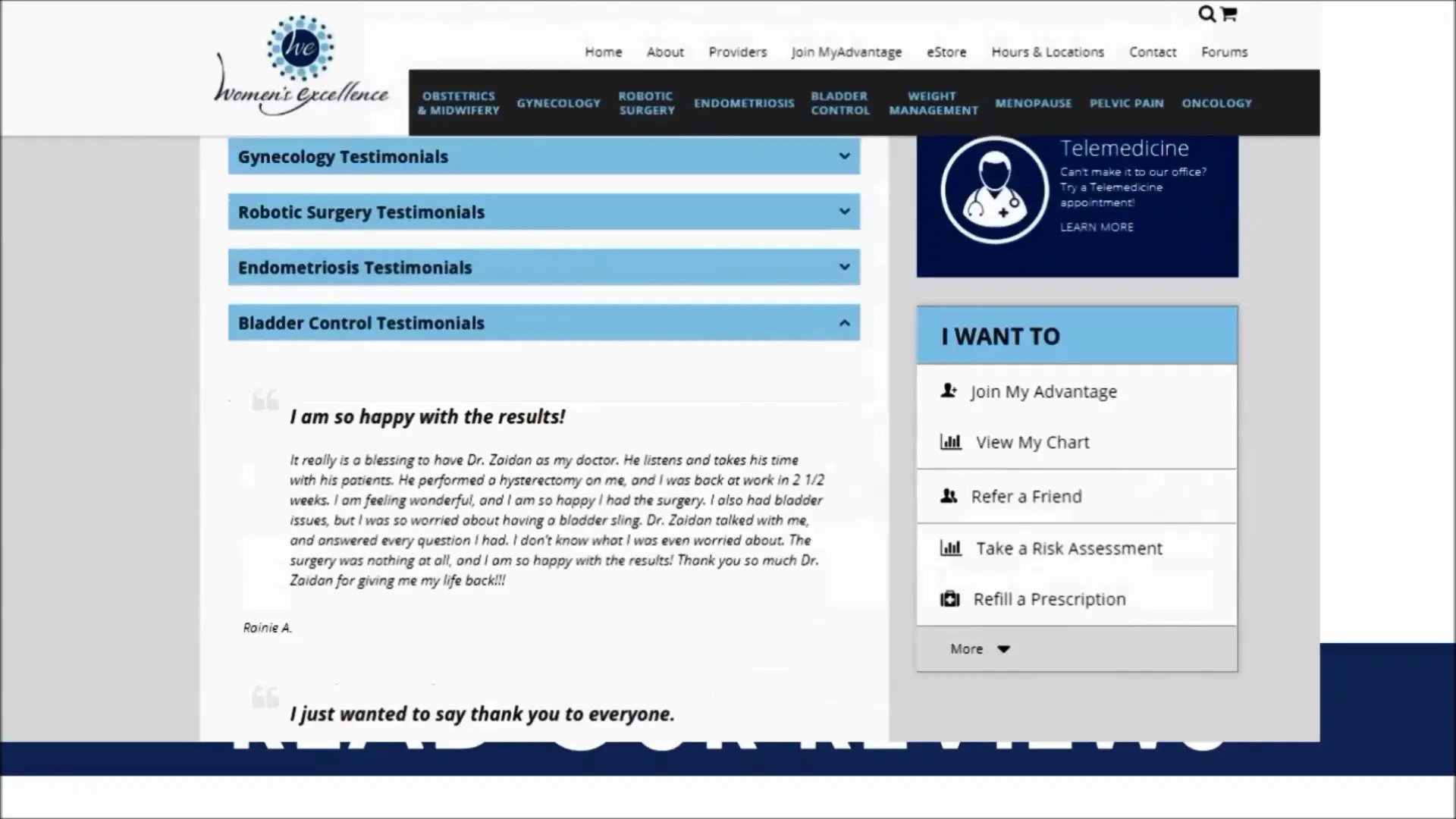Abdominal/Pelvic Adhesions
At Women’s Excellence in Robotic Surgery we are specialists trained to treat adhesions (otherwise known as scar tissue) that form between the intraperitoneal organs of the body. The cavity that contains the stomach, the bowel and the uterus is called the peritoneal cavity. A woman’s fallopian tubes and ovaries are also within that cavity. Often times if there is an inflammatory process within the abdominal or pelvic cavity, scar tissue can form. The scar tissue that forms is referred to as adhesions. Adhesions can be severe or they can be mild. Mild adhesions cause organs to be connected, but not necessarily fixed to one another. More extensive adhesions can cause organs to be fixed to the organ or structure adjacent to it. In any event, both mild adhesions and extensive adhesions can cause severe pelvic discomfort. They can also cause bowel obstruction, abdominal bloating, and an overall generalized abdominal or pelvic pain. If adhesions are present, whether they have been separated surgically in the past or if they have not been treated previously, the symptoms can be significant. Laparoscopic or robotic surgical approaches can visualize the intraperitoneal cavity and often times lyse (cut) adhesions. Although a lysis of adhesions procedure has some risks, including the potential to injure the bowel, bowel injuries are unlikely and happen in few people that undergo robotic or laparoscopic surgery. Adhesions that are encountered during robotic or laparoscopic surgery can be cut with special minimally invasive scissors and many of the symptoms caused by the presence of adhesions can resolve. There is a chance that adhesions can reform. However, if some adhesions that are causing a woman pelvic discomfort are lysed or cut, the patient may experience significant relief of the discomfort that she has been experiencing. There are also new anti-adhesion barriers such as Interceed, Adept, and Seprafilm that can help prevent future adhesion formation. If you have had previous pelvic surgery or any previous inflammatory condition of the pelvis such as pelvic infection, endometriosis, a complicated child birth, and or cesarean section and are having symptoms of pelvic pain, bloating or painful intercourse you may have adhesions. If you believe that adhesions may be responsible for your discomfort, call the specialists at Women’s Excellence in Robotic Surgery to schedule an appointment.
Adenomyosis
Adenomyosis is a condition when the tissue that is normally inside the lining of the uterus, the endometrium, grows inside the muscle layer of the uterus. It is a very painful condition that can be helped with treatment. The most common symptoms of adenomyosis are similar to the symptoms of endometriosis and may include pelvic pain, painful intercourse, severe menstrual cramping and irregular bleeding. In order to confirm the diagnosis we fully evaluate your symptoms, perform physical examination and obtain ultrasound evaluation. If adenomyosis is suspected, we can then establish the diagnosis with a minimally invasive outpatient laparoscopic evaluation to rule out endometriosis and also look at the consistency of the uterine wall. Adenomyosis typically makes the wall soft and globular. Adenomyosis can also be strongly suspected based upon a pelvic MRI study. The diagnosis is still one of suspicion as the actual diagnosis cannot be made without pathologic specimens, which can only occur with removal of a part or all of the uterus itself. Once the diagnosis of adenomyosis is suspected and concomitant endometriosis, if present, has been identified, many options for treatment can be initiated. The symptoms of adenomyosis alone, like endometriosis, can be severe and can lead to a total change in lifestyle and employment during the menstrual cycle. If you have symptoms of adenomyosis or endometriosis and want a comprehensive evaluation to establish a treatment plan, call to set up a consultation. Our specialists at Women’s Excellence in Robotic Surgery have developed a center that is designed to manage all the ramifications of patients with adenomyosis alone or patients who have both adenomyosis as well as endometriosis. As a thought leader in treatment of chronic pelvic pain, Women’s Excellence in Robotic Surgery can help both mild & severe cases of Adenomyosis as well as Endometriosis.
Infertility Secondary to Adhesions or Endometriosis
Infertility secondary to adhesions or endometriosis At Women’s Excellence in Robotic Surgery we are confronted with many types of fertility. We specialize in infertility that is present as a result of endometriosis and/or pelvic/tubal adhesive disease. We understand that in vitro fertilization is an option to conceive, but many of our patients would rather conceive naturally and wish to treat not only their symptoms but also the pelvic discomfort and dysmenorrhea (painful periods) they experience as well. Our specialists will obtain a thorough history of your problem, perform a comprehensive physical examination, visualize the pelvis with radiologic testing such as ultrasonography, CAT scan and/or MRI in order to determine if you are a good surgical candidate. If surgical therapy is indicated, we will use robotic surgical techniques with high definition 3-dimensional visualization in order to restore the tubal architecture and anatomy. At the same surgical session we will resect adhesions and endometriosis in order to increase the time period that you can experience pain relief and hopefully be amenable for conception. Of course, we will test the tubal patency to ensure they are open so no time is wasted on conception if the chances are minimal. If you have infertility and have been told it is a result of endometriosis or adhesions, call Women’s Excellence in Robotic Surgery for a consultation. WE can Help!
Pelvic Organ Prolapse
Too often, a patient has pelvic organ prolapse which is disregarded as a physician searches for another source of pain. In some instances, the bladder can drop below the supportive anterior vaginal wall which is called a cystocoele. In other cases, the rectal wall can also bulge above the supportive rectal vaginal wall which is referred to as a rectocoele. At other times all of the pelvic organs including the uterus or the upper portion of the vagina, if the patient has had a hysterectomy, can protrude down into lower portion of the vagina or even outside of the opening of the vagina and this is called Pelvic Organ Prolapse. If a prolapse condition occurs, minimally invasive and more extensive surgical interventions can be performed to restore a more anatomically correct pelvic anatomy. With surgery, these organs can be restored to their normal and anatomically position. Robotic or traditional open sacrocolpopexy is the gold standard method to correct pelvic organ prolpase. Once the repair is completed the patient is often relieved of the pressure symptomatology that she experiences, as well as the unsightly and uncomfortable nature of having the pelvic organs in the lower vaginal vault or outside the vaginal opening and the discomfort will be alleviated. If you have pelvic pain and also have symptoms of pelvic organ prolapse, call Women’s Excellence in Robotic Surgery for a consultation.
Preservation of Fertility
Robotic Reproductive Surgery has brought the opportunity to perform complex reproductive surgeries through a minimally invasive approach. Robotic surgery allows us to use more precise dissection, better visualization and improved ability to suture In the minimally invasive environment which makes it a perfect choice for reproductive surgery. We currently offer robotic tubal reversal and reconstructive tubal surgery, robotic myomectomy, and robotic reconstruction of mullerian anomalies for those women who have had a congential uterine anomaly.
If you or someone you know is experiencing infertility and surgery is an option, call the specialists at Women’s Excellence in Robotic Surgery for a consultation, WE can Help!
Robotic Hysterectomy
Until recently, surgery for most gynecologic conditions was performed using a large abdominal incision. This is because while conventional laparoscopic surgery is effective for many routine procedures, the long-handled, rigid instruments used in laparoscopy are not usually considered effective for delicate or complex operations. At Women’s Excellence in Robotic Surgery we can provide hysterectomy through laparoscopic approaches but there are times when robotic surgery is a better alternative, especially when there is complex disease such as severe endometriosis or known severe pelvic adhesions. Robotic Surgery is a minimally invasive option for treating gynecologic conditions designed to overcome the limits of traditional open and laparoscopic surgery.Minimally invasive surgery allow you to get back to your life faster. Robotic surgery enables our specialists at Women’s Excellence in Robotic Surgery to perform a minimally invasive hysterectomy for the complex conditions — with enhanced vision, precision, dexterity and control. The potential benefits of robotic surgery are similar to laparoscopic surgery benefits over traditional surgery, including:
- Less pain
- Fewer complications
- Less blood loss
- Shorter hospital stay
- Low risk of wound infection
- Quicker recovery and return to normal activities
The Robotic Surgery System is a state-of-the-art surgical platform with 3D, high-definition vision and miniaturized, wristed surgical instruments designed to help doctors to overcome the challenges of traditional open and laparoscopic surgery, At Women’s Excellence in Robotic Surgery, we are specially trained to utilize this technology to help our patients.
Robotic Lysis of Adhesions with Adhesion Barrier Placement
Robotic Lysis of adhesions and placement of adhesion barriers until the development and usage of robotic surgery we had traditional approaches to remove adhesions (otherwise known as scar tissue) that form between the intra-peritoneal organs of the body. The majority of surgeries to treat adhesions in the past were through open incisional techniques that required a long healing time and a rather large incision. The limitations of this approach revolved around two main issues. First, the fact that a large incision was very likely to provide an extensive disruption to the natural environment in the abdominal pelvic cavity and this disruption led to more adhesions. Second, as a result of the inflammatory scarring the posterior (back side) of the pelvis was difficult to assess with the large incisional approach as the entry point was the front of the abdomen. Laparoscopy then became and remains the most common way of diagnosing adhesions. Laparoscopy eliminated the large incision and the ability to see the posterior pelvic cavity but although effective in many cases, lacked the precision and dexterity to dissect and remove adhesions in the complicated patient. At Women’s Excellence in Robotic Surgery, we believe the robotic surgical approach to adhesions is far superior in the patient with complicated adhesions as it not only allows enhanced visualization and precision which provides our specialists the ability to dissect well, resect adhesions and place adhesion barriers but it most importantly provides the patient with a minimally invasive approach which is associated with less recurrent adhesion formation. Robotic surgery really provides the incisions of a laparoscopic approach and provides the precision of an open surgery as well as the ability to provide the surgery even on the most extensive posterior pelvic adhesion disease. This is why at Women’s Excellence in Robotic Surgery, we believe that robotic lysis of adhesions is the best way to remove adhesions in the very complicated patient as long as the patient is a candidate for robotic surgery and most patients are. For these reasons, we utilize robotic surgery as our surgical approach for patients with extensive and complicated adhesions as it is far superior to traditional open surgery. At Women’s Excellence in Robotic Surgery, our specialists establish a diagnosis of adhesions based on a thorough history, a comprehensive physical and pelvic examination, ultrasound and possibly even laparoscopy. Once the diagnosis of adhesions has been established, especially complex pelvic, bowel or tubal adhesions, we can then provide a robotic approach. As discussed earlier, robotic surgery is really the best surgical approach for these patients as the enhanced visualization and the ability to provide precision dissection with a minimally invasive method is far superior to traditional open surgery. We also have a better ability to place the anti-adhesion barriers such as Interceed, Adept, and Seprafilm that can help prevent future adhesion formation with a robotic approach. If you have had previous pelvic surgery or any previous inflammatory condition of the pelvis such as pelvic infection, endometriosis, a complicated child birth, and or cesarean section and are having symptoms of pelvic pain, bloating or painful intercourse you may have adhesions. If you believe that adhesions may be responsible for your discomfort, call the specialists at Women’s Excellence in Robotic Surgery to schedule an appointment.
Robotic Myomectomy
The specialists at Women’s Excellence in Robotic Surgery can now remove uterine fibroids with a minimally invasive method. Using Robotic technology, a Da Vinci Robotic Myomectomy, combines the best of open and laparoscopic surgery. With the assistance of the da Vinci Surgical System — the latest evolution in robotics technology — The specialists at Women’s Excellence in Robotic Surgery can remove uterine fibroids through small incisions with unmatched precision and control. The benefits of robotic Myomectomy as compared to traditional open abdominal surgery are:
- Potential increased opportunity for future pregnancy
- Significantly less pain
- Less blood loss
- Fewer complications
- Less scarring
- A shorter hospital stay
- A faster return to normal daily activities
The robotic surgical approach allows us to perform a minimally invasive, yet remarkably precise, comprehensive reconstruction of the uterine wall, regardless of the size or location of your fibroids. It is the unique level of control and precision that we are able to achieve with robotics that allows us to provide what we believe is a far more precise and thorough reconstruction than we could achieve with traditional open surgery. The specialists at Women’s Excellence in Robotic Surgery strongly believe that the precise reconstruction of the uterine wall, especially after removal of the posterior (towards the back) fibroids that are extremely difficult with open surgery, may help to prevent a possible uterine rupture (tearing) during future pregnancies. As with any surgery, these benefits cannot be guaranteed, as surgery is unique to each patient and procedure. While robotic myomectomy is considered safe and effective, this procedure may not be appropriate for every individual. At Women’s Excellence in Robotic Surgery, we can determine through a comprehensive history, physical, ultrasonograpic exam and possibly a magnetic resonance test (MRI) if you are a good candidate for myomectomy. Call us for a consultation, WE can Help!
Excision Of Endometriosis
Excision of endometriosis – Looking to cure disease and minimize recurrence. At Women’s Excellence in Robotic Surgery we pride ourselves in the expert treatment of the conditions of which we provide care. Clearly, the resection of endometriosis completely embodies this comprehensive expert treatment approach. Traditionally, laparoscopy has been used to diagnose and treat endometriosis, unless the disease was extensive and severe when open large incisional approaches were utilize. Although laparoscopic ablation of endometriosis is an effective tool to help control endometriosis, it is certainly not considered a curative type procedure. If the open technique was employed in the past it usually was used to perform hysterectomy in order to cure disease. The latest surgical technologic revolution revolves around the introduction of Davinci robotic technology. Although, the specialists at Women’s Excellence in Robotic Surgery do not believe that the Da Vinci Robot is better than other minimally invasive procedures for all interventions, we believe that Da Vinci robotic resection of endometriosis is far superior to standard ablative measures for endometriosis. It may even offer a cure. Using the enhanced 3D, high definition vision and the precision of wristed robotic instrumentation, robotic surgery allows the surgeon the ability to dissect far better. With Da Vinci robotic technology applied to the complicated endometriosis patient, the specialists at Women’s Excellence in Robotic Surgery are able to excise the lesions that are causing pain and discomfort and eliminate the chance for recurrence in those areas. While doing so we can often remove endometriosis that is adjacent to other vital organs, without harming those vital organs. Amazing technology! We are also able to achieve very comprehensive pathologic diagnosis and evaluate the disease to determine which hormones the lesions are most susceptible which allows us to better determine the follow-up treatment regimens. This ability to do this with a minimally invasive surgery is completely new and the ability to dissect with precision movements with high definition optics is unparalleled by any other surgical method. As an expert in endometriosis resection utilizing Da Vinci robotic technology in the treatment of endometriosis, Dr. Jonathan Zaidan MD FACOG, the founder of Women’s Excellence in Robotic Surgery, is contributing to advancing the treatment of quality of life and fertility altering disease of endometriosis.
Robotic Surgery for Endometriosis and Uterine Fibroids, Preserving Fertility
It is estimated that 20 to 40 percent of all American women have uterine fibroids, masses of smooth muscle cells that grow in the uterus. And 6 to 15 percent of American women are affected by endometriosis, a condition in which cells that normally grow inside the uterus grow outside of the uterus instead. While many women with these conditions have few if any symptoms, others experience mild to severe pelvic pain and excessive menstrual bleeding. And both conditions can adversely affect a woman’s ability to conceive. In fact, up to 40 percent of infertile women are found to have endometriosis.
While there are a variety of options available to treat both uterine fibroids and endometriosis, some women with severe symptoms or women who are unable to conceive because of these conditions face the need for surgical intervention. That can mean undergoing open abdominal surgery, which requires a two- to three-day hospital stay and up to six weeks to fully recover, often with strict limitations. But now, thanks to a minimally invasive procedure called robotic-assisted surgery, these same women can be back to doing normal activities within a week.
Women’s Excellence in Robotic Surgery offers robotic laparoscopic surgery for a wide variety of female reproductive disorders including uterine fibroids, fallopian tube repair and endometriosis. Although we cannot say the success rate for alleviating symptoms and restoring fertility are the improved with robotic-assisted surgery as compared to open abdominal surgery, we are aware that robotic-assisted surgery offers patients additional benefits. It is clear to our specialists at Women’s Excellence in Robotic Surgery that following robotic-assisted surgery, patients recover with less pain and discomfort and can expect to return to normal routines including work, social functioning and even exercise within a week. Robotic-assisted surgery also lessens the potential of complications such as infection, bleeding and poor wound healing. Although the need for treatment is paramount in surgery to help for reproduction, there is also an improved cosmetic result as a result of the smaller incisions which is beneficial to the younger fertility aged patient.
At Women’s Excellence in Robotic Surgery we determine a woman’s eligibility for robotic-assisted surgery to treat uterine fibroids or endometriosis based on a variety of factors including the severity of her condition and whether she has undergone previous surgeries. Women’s Excellence in Robotic Surgery also offers the option of robotic-assisted surgery to women seeking reversal of fallopian tube sterilization. Although reversal of tubal sterilization is performed less frequently due to the availability and success of in vitro fertilization, some women prefer to conceive naturally and may desire multiple children. Robotic-assisted surgery offers suitable candidates another option for regaining fertility with a quicker recovery time than other surgical approaches.
Robotic Surgery for Uterine or Vaginal Vault Prolapse (Sacrocolpopexy)
The specialists at Women’s Excellence in Robotic Surgery understand that surgery is often the best treatment option to repair pelvic prolapse, including vaginal vault prolapse. Once we obtain the history of your problem, perform a physical exam, evaluate the architecture of your pelvic organs with ultrasonography and interpret testing of your bladder function, we can determine the best way to completely repair the prolapse. The surgical approach to repair uterovaginal/vaginal vault pelvic prolapse surgical is known as sacrocolpopexy. Surgical mesh is used to hold the affected pelvic organ(s) in the correct anatomical position. This procedure can also be performed after a hysterectomy to treat vaginal vault prolapse. It provides long-term support of the vagina.
Prolapse surgery has traditionally been performed as open surgery. A long horizontal incision is made in the lower abdomen to access the pelvic organs, but recovery after open surgery can be lengthy. Prolapse surgery can also be performed minimally invasively – through small incisions – with laparoscopic surgery. However, traditional laparoscopy may present challenges due to the long-handled, rigid instruments needed for the procedure. Fortunately, there robotic surgery offers a minimally invasive option that overcomes the limits of traditional open and laparoscopic surgery. Although the recovery of this procedure is still significant it reduces the length of the open scar and some of the pain associated with the larger incision.
If you need surgery to treat pelvic organ prolapse, Robotic Sacrocolpopexy, using state-of-the-art technology, requires some smaller incisions, so you can avoid a larger procedure. Using robotics, the specialists at Women’s Excellence in Robotic Surgery are able to operate with enhanced vision, precision, dexterity and control. The 3-dimensional, high-definition vision system allows surgeons to see key anatomy with immense depth and clarity– critical for complex conditions.
Robotic Sacrocolpopexy offers several potential benefits over traditional open surgery, including:
• Less blood loss
• Minimal need for blood transfusions
• Shorter hospital stay
Potential benefits of Robotic surgery compared to traditional laparoscopy include:
• Better visualization
• More precise dissection
• Improved dexterity during the procedure allowing better graft placement
Robotic technology, using state-of-the-art surgical platform with 3D, high-definition vision and miniaturized, wristed instruments, helps us overcome the challenges of traditional open and laparoscopic surgery and as a result we are changing the experience of surgery for the women we treat.
If you have been putting off treatment for pelvic prolapse, it’s time to call us regarding a robotic surgical approach. As with any surgery, these benefits cannot be guaranteed since surgery is specific to each patient, condition and procedure. At Women’s Excellence in Robotic Surgery, we can determine through a comprehensive history, physical, ultrasonograpic exam and bladder function testing, if you are a good candidate for sacrocolpopexy. Call us for a consultation, WE can Help!







